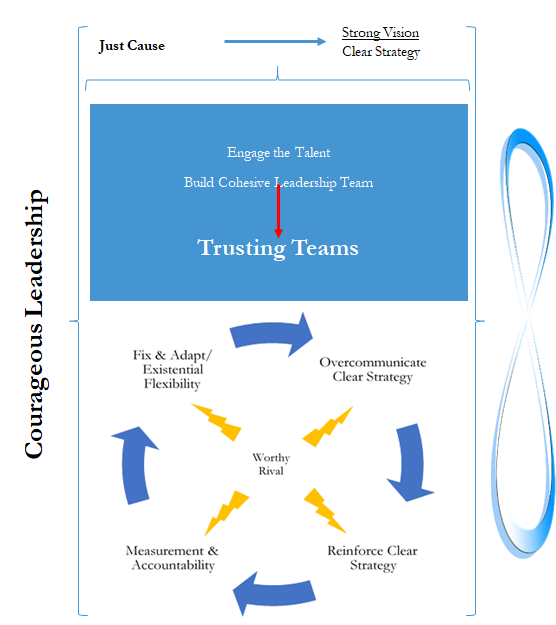At the EntreLeadership Summit (@EntreLeadership) of 2019, three of the speakers, Dr. Henry Cloud, Patrick Lencioni, and Simon Sinek spoke and their messages really coalesced into a unified message. As I listened to and reflected on each of them, they were some of the best times that I’d heard them speak. Each presentation was excellent in its own right but I knew there was something more. I felt that put together, they would form part of a larger, better message.
Below I’ve laid out a brief of each main point of each presentation. At the end, I then put together a matrix of how they all inter-related.
Dr. Henry Cloud (@DrHenryCloud)
I’ve heard Henry Cloud speak a number of times. This was, by far, the best presentation that I’ve heard him deliver. His topic was Desired Future:Vision or Fantasy.
The desired future of an organization is the compelling vision that the leader of the organization lays out for the team. There are Five Elements of a Desired Future:

1. A Strong Vision
2. Engaging the Talent
3. Executing a Strategy
4. Measurement and Accountability
5. Fix and Adapt to What I Find
To accomplish the desired future, there are several questions that must be asked:
- Does everyone understand why we are here? (How compelling is our vision?)
- Who is around the table who doesn’t fit the future?
- How far do I let people stretch versus letting them down with the vision?
Patrick Lencioni (@patricklencioni)
Patrick Lencioni is one of my absolute favorite speakers. For my money, I would like to hear him speak at every leadership event I attend. He always brings something fresh for his audience. This session was no exception as he spoke on the four disciplines of a healthy organization which include:
1. Build a Cohesive Leadership Team
2. Create Clarity
3. Over-communicate Clarity
4. Reinforce Clarity

As you can see, clarity is important.
Simon Sinek
This was the first time that I had really heard Simon Sinek speak beyond a clip here or there on social media. He spoke on the concept of the Infinite Game. In the infinite game, the goal is to outlast your competition. He shared that the Vietnam war was an example of the infinite game where the U.S. lost the will to keep playing. In the infinite game, we consider how people achieve not just that they achieve. The infinite game has these characteristics:
- known and unknown players
- rules can change
- new players can join
- play to stay playing
The Infinite Game is what we do in our businesses, educational institutions, non-profits, etc. We “play to stay playing” and “outlast our competition.”
To lead within the Infinite Game, Sinek related that we must have the following things:

1. Just Cause: A cause so just you’d be willing to sacrifice your own interests to advance it.
2. Trusting Teams: Companies must trust their employees/team.
3. Worthy Rival: A worthy rival is one that shows you your weaknesses.
4. Capacity for Existential Flexibility: Flexibility to profoundly affect your organization (a profound shift in strategy and course).
5. Courage to Lead: Willingness to recognize that the rules to win and the game we play are not necessarily aligned.
When you put all three of these addresses together, there are some interesting interactions. A Courageous Leader with a Just Cause in hand enters the Infinite Game yielding a Strong Vision supported by Clear Strategy. As a next logical step, the Courageous Leader Engages the Talent, Builds a Cohesive Leadership Team which yields Trusting Teams. With a Trusting and Trustworthy Team, Clear Strategy is implemented, over-communicated, reinforced, measured, made accountable, and updated (sometimes drastically) based on the measurement and the Worthy Rival showing improvements needed.


Comments are closed